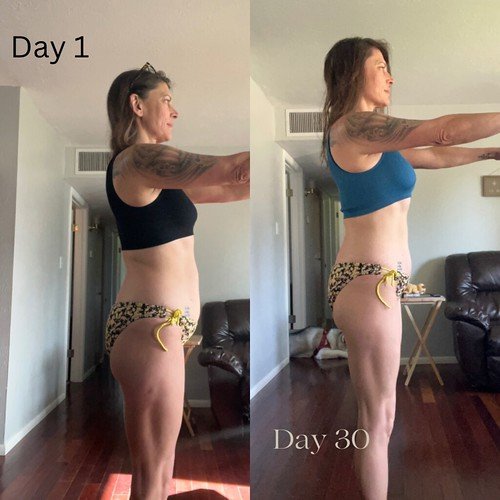
Belly fat can be stubborn and frustrating, but losing it doesn’t have to be a long, drawn-out process. In just two weeks, you can kickstart your journey to a flatter stomach with the right strategies. I’ve discovered effective methods that not only help shed those extra pounds but also boost overall health.
Understanding Belly Fat
Belly fat encompasses different types and poses various health risks. Recognizing these aspects is crucial for effective weight loss strategies.
Types of Belly Fat
- Subcutaneous Fat: Subcutaneous fat lies just beneath the skin. This type is more visible and often feels soft to the touch. It contributes to the body’s overall shape and is generally less harmful than visceral fat.
- Visceral Fat: Visceral fat surrounds internal organs like the liver and pancreas. This type is more dangerous and associates with serious health issues, such as heart disease and diabetes. Its reduction is critical for improving overall health.
- Intramuscular Fat: Intramuscular fat exists within muscle tissue. It’s seen in both lean and overweight individuals. Although not as dangerous as visceral fat, excess amounts can impact muscle function and metabolism.
- Cardiovascular Disease: Increased belly fat connects with a higher risk of heart disease. The accumulation of visceral fat leads to higher cholesterol and blood pressure levels.
- Type 2 Diabetes: Excess abdominal fat contributes to insulin resistance, increasing the likelihood of developing type 2 diabetes. Lowering belly fat can significantly reduce this risk.
- Certain Cancers: Research shows a relationship between high levels of belly fat and increased risks of certain cancers, including breast and colorectal cancer. Reducing abdominal fat may lower these risks.
- Metabolic Syndrome: Accumulation of belly fat may lead to metabolic syndrome, which includes a cluster of conditions like high blood pressure, high blood sugar, and abnormal cholesterol levels. This syndrome significantly heightens heart disease and stroke risks.
- Sleep Apnea: Increased abdominal fat can contribute to sleep apnea, a condition where breathing briefly stops during sleep. Losing belly fat can improve sleep quality and overall health.
Diet Tips for Losing Belly Fat
Diet plays a vital role in losing belly fat. Implementing specific dietary changes can lead to noticeable results in just two weeks.
Foods to Include
- Leafy Greens: Spinach, kale, and Swiss chard are low in calories and high in fiber. These greens help promote feelings of fullness.
- Fruits: Berries, apples, and oranges provide vitamins and antioxidants. Their fiber content also aids digestion and curbs hunger.
- Lean Proteins: Chicken breast, turkey, and legumes support muscle maintenance and increase metabolism, leading to better fat burn.
- Whole Grains: Oats, quinoa, and brown rice contain complex carbohydrates, which provide energy and sustained fullness.
- Healthy Fats: Avocados, nuts, and olive oil contain monounsaturated fats that support heart health and reduce inflammation.
- Sugary Beverages: Soda, fruit juices, and energy drinks contain hidden sugars that contribute to belly fat accumulation.
- Processed Foods: Chips, cookies, and fast food often contain unhealthy trans fats and added sugars that promote weight gain.
- Refined Carbohydrates: White bread, pastries, and pasta can spike blood sugar levels and increase cravings, leading to overeating.
- Excessive Alcohol: Beer and sugary cocktails may lead to weight gain, commonly referred to as “beer belly.”
- High-Sodium Foods: Processed meats, canned soups, and frozen meals can cause water retention, which may increase the appearance of belly fat.

Exercise Routines for Belly Fat Loss
Integrating exercise routines into my daily schedule significantly enhances belly fat loss. Focus on a combination of cardio workouts and strength training exercises to achieve effective results within two weeks.
Cardio Workouts
Cardio workouts elevate heart rate and boost calorie burn, essential for reducing belly fat. Activities like running, cycling, or brisk walking engage large muscle groups and promote fat loss. Aim for at least 150 minutes of moderate-intensity cardio each week. High-Intensity Interval Training (HIIT) provides additional benefits, mixing short bursts of intense activity with recovery periods. Consider these effective cardio options:
- Running: Engage in incline sessions for added intensity.
- Cycling: Use stationary bikes for indoor workouts or explore cycling trails.
- Jump Rope: Incorporate intervals for a full-body workout.
- Swimming: Utilize various strokes to diversify the training effect.
Strength Training Exercises
Strength training exercises build muscle, which increases metabolism and supports fat loss. Incorporating strength workouts into my routine enhances muscle tone and firmness, specifically targeting the abdominal area. Focus on compound movements that work multiple muscle groups for maximum effectiveness. Implement these strength training exercises:
- Planks: Hold for 30–60 seconds to engage the core effectively.
- Squats: Use body weight or resistance for intensity.
- Deadlifts: Perform with proper form to engage multiple muscle groups.
- Push-Ups: Modify as needed to build upper body strength.
- Lunges: Use variations like walking lunges for comprehensive leg development.
Combining cardio and strength training optimizes fat loss and fosters overall health. Adopting this balanced approach allows me to make meaningful progress toward losing belly fat in two weeks.

Lifestyle Changes to Support Fat Loss
Lifestyle changes play a critical role in supporting fat loss. Adopting healthy habits can significantly enhance the effectiveness of dietary changes and workout routines.
Importance of Sleep
Sleep impacts weight loss more than many realize. Poor sleep disrupts hormones like ghrelin and leptin that control hunger, leading to increased appetite and cravings. Aim for 7 to 9 hours of quality sleep each night. Establish a consistent sleep schedule, create a calming bedtime routine, and limit screen time before bed. These practices help improve sleep quality, support metabolism, and foster overall health.
Stress Management Techniques
Effective stress management is vital for losing belly fat. High stress levels trigger cortisol release, which contributes to fat accumulation, especially around the abdomen. Integrate stress-reduction techniques into my daily routine. Techniques such as meditation, deep breathing exercises, and yoga can lower stress and cortisol levels. Incorporating physical activities I enjoy, such as dancing or hiking, also helps alleviate stress. These practices not only support fat loss but enhance overall well-being.
Monitoring Your Progress
Monitoring progress is essential for staying motivated and ensuring effectiveness in belly fat loss. By implementing the right strategies, I can track my journey and make necessary adjustments along the way.
Setting Realistic Goals
Setting realistic goals facilitates clear direction and measurable outcomes. I set specific, achievable targets, such as losing 1 to 2 pounds per week or reducing waist circumference by 1 to 2 inches within two weeks. These guidelines are attainable and foster steady progress. Regularly assessing these goals keeps me focused and motivated.
Tracking Tools and Methods
Tracking tools and methods provide accountability in the belly fat loss process. I use various options, including:
- Fitness Apps: Apps like MyFitnessPal or Lose It! help monitor daily caloric intake and exercise.
- Wearable Devices: Fitness trackers like Fitbit or Apple Watch offer real-time data on activity levels and heart rate.
- Journals: Keeping a food and exercise journal helps me reflect on habits and stay committed.
- Measuring Tape: Regularly measuring waist circumference gives a tangible indicator of progress.
Using these tools helps ensure I stay on track, making it easier to adjust my approach as needed.
Conclusion
Losing belly fat in just two weeks is achievable with the right approach. By making smart dietary choices and incorporating effective exercise routines, I can kickstart my fat loss journey. It’s all about understanding the types of belly fat and the associated health risks, which motivates me to stay focused.
Integrating lifestyle changes like improving my sleep quality and managing stress has made a significant difference. These adjustments not only support my goal of losing belly fat but also enhance my overall well-being.
As I track my progress and set realistic goals, I find it easier to stay motivated. With determination and the right strategies, I can see real results and pave the way for a healthier future.


